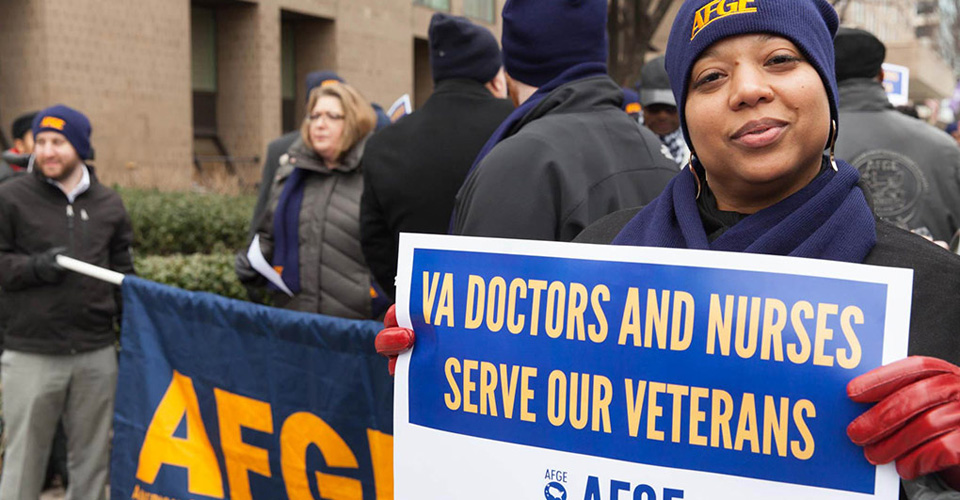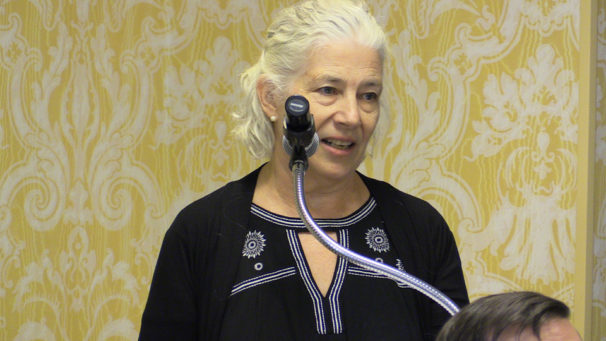
People’s World took home 22 awards from the 2017 Labor Media Awards at this year’s convention of the International Labor Communications Association in St. Louis. PW Senior Editor Roberta Wood won the top honor, the prestigious Max Steinbock Award, for her story, Veterans’ Health Care in Crosshairs of Privatization Forces. This is the text of the keynote address she delivered at the awards ceremony on Oct. 20.
I’m not a professional journalist. My apprenticeship with writing in the 1970s was served parallel to my apprenticeship at U.S. Steel, where I trained to be a journeyman industrial instrument mechanic.
In those days, we actually cut with scissors and pasted with scotch tape to assemble rank-and-file newsletters, which we distributed at the gates of U.S. Steel South Works in Chicago at the beginning and end of shifts. The Rank and File Voice was a popular item because we regularly vilified members of management as the “Millrat of the Month.” It was satisfying to writers and readers to see some of these rats get their claws clipped when their misdeeds were exposed.
We campaigned on issues of safer working conditions, an end to discrimination, and union democracy. A newsletter was also the core for organizing the first Steelworkers Women’s Caucus. We addressed filthy bathrooms, pregnancy leave, affirmative action, and an issue that at that time had no name, but came to be described as sexual harassment.
At that time, union publications would not carry our voices. It was the official position of the AFL-CIO to support the war in Vietnam, oppose affirmative action, and support deportation of immigrants. The rank-and-file movement and its newsletters played a huge role in restoring the proper role of the labor movement we take for granted today.
I was drawn to this story about saving the VA because it seems like veterans’ voices are not being heard and a light needed to be shined on the outrageous abuse of their sacrifices.
The Veterans Administration has what many would say is the best health care system in the country. Its budget is in the scores of billions. It goes beyond single payer—with no profit involvement at all. It is nationalized health care.
Its doctors and nurses are direct government employees. The care veterans get is seamless and completely comprehensive; this is critical for people with conditions like traumatic brain injury. Its workforce is professional and unionized. A typical doctor’s appointment is half-an-hour. In the private sector, you’re lucky to get 15 minutes. The level of satisfaction of VA’s users is extremely high.
Yet a series of unending and overlapping wars have poured thousands of new, severely injured patients into the system with no corresponding increase in funding. In 2014, union workers in the VA system were the courageous whistleblowers who revealed problems with long waiting lists for services.
At the same time, a new organization with the word “veteran” in its name appeared. But it wasn’t organized by veterans, it was founded and funded by the billionaire Koch brothers. The veterans’ groups we are all familiar with, like American Legion, Paralyzed Veterans of America, and VFW, are organized around providing services. But the Kochs’ “Concerned Veterans” had a different mission. They were set up only as a lobbying operation—and it wasn’t veterans they were lobbying for. They appropriated only the veterans’ name, not their care.
The shortfall in care at VA was portrayed as a scandal. It was made out to be the fault of the very union staff that had brought it to public attention. It was made out to be the fault of the VA’s comprehensive not-for-profit system itself.
Instead of increasing VA funding, Congress appointed a “Commission on Care” to study the problem. The commission included no representatives of VA’s work force; it included not one legitimate veterans’ organization. But it did make seat at the table for the newly minted “Concerned Veterans,” along with representatives of private, for-profit health care providers.

The logical solution to the problem of an overburdened veterans’ health care system would be to increase its funding and stop the wars that overflow its facilities.
But instead, the Commission recommended a plan to dismantle the VA and divert its funding to privatized services. The privatization was disguised with terms like “community-based” and “choice.”
All the legitimate veterans’ organizations, those that provide real services to vets, issued a joint statement of outrage. But they didn’t seem to have the mechanism in place for effective mobilization of the veterans they serve.
It was the American Federation of Government Employees (AFGE) that was the most active voice—a large percentage of its members are themselves vets. AFGE’s president, J. David Cox served for years as a VA nurse. AFGE mobilizes both its members and the veteran community.
AFGE points out that there are today over 49,000 unfilled positions of doctors, nurses, and other caregivers in the VA system that make it impossible for the agency to give veterans the care they have been promised. AFGE has launched a petition and phone campaign to fill these positions and invited any organization to partner with them against the privatization of veteran health care.
The attack on the VA follows an ugly pattern that we see over and over.
It follows a template for undermining institutions that serve working people: cut their funding, institute practices to sabotage their missions, use the resulting problems to criticize the workers and the services, drum up support to break up collective institutions, and inject privatization at every level of the project.
We see it again and again: a profit-based economy seeks out pots of money to grab—Social Security, Medicare, Medicaid, education funding, disaster relief, and the postal service are all recent examples. Where these privatization schemes succeed, they underlie a large part of the transfer of wealth from workers to the “1 percent” that we see in today’s growing income gap.
Frequently, the corporate attack is bi-partisan: The sequence of events described above all happened BEFORE the Trump administration.
Republican vs. Democrat doesn’t adequately describe the battle lines. For example, the privatization-biased “Commission on Care,” which included neither worker representatives nor real veterans’ advocates, was appointed by leaders of Congress from both parties and a Democratic president.
On the other hand, veterans and groups like the American Legion are typically seen as “right-wing,” yet on this issue, they are labor’s allies. So the battle lines in this struggle aren’t “left versus right” either.
Instead, it’s right versus wrong, where the battle lines are drawn in the struggle for justice for veterans—fairness versus injustice; people before profits; and the right of the American people to take care of our own without sabotage and pay-offs to corporate moochers.
The story of the abandonment of veterans under the guise of honoring their sacrifices is a complicated story we have to explain, blending human storytelling and facts.
We need to tell this story right because the American working class values of fairness, generosity, and collective responsibility are being high-jacked by profit-seeking corporate forces to justify the destruction of the most important resource our veteran brothers and sisters have.
It’s collective action by our working class that will guarantee our nation fulfills its sacred obligation to our vets and not let their care be replaced by privatization and profitization by corporate America.










